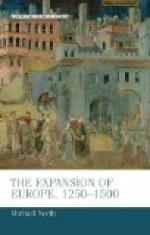The principle of the protection of backward peoples has, however, sometimes had an unfortunate influence upon colonial policy; and there was no colony in which it exercised a more unhappy effect than South Africa. Here the Boer farmers still retained towards their native neighbours the attitude which had been characteristic of all the European peoples in the seventeenth and eighteenth centuries: they regarded the negro as a natural inferior, born to servitude. It is not surprising that no love was lost between the Boers and the missionaries, who appeared as the protectors of the negroes, and whose representations turned British opinion violently against the whole Boer community. This was in itself a sufficiently unfortunate result: it lies largely at the base of the prolonged disharmony which divided the two peoples in South Africa. The belief that the Boers could not be trusted to deal fairly with the natives formed, for a long period, the chief reason which urged the British Government to retain their control over the Boers, even when they had trekked away from the Cape (1836) and established themselves beyond the Orange and the Vaal rivers; and the conflict of this motive with the desire to avoid any increase of colonial responsibilities, and with the feeling that if the Boers disliked the British system, they had better be left in freedom to organise themselves in their own way, accounts for the curious vacillation in the policy of the period on this question. At first the trekkers were left to themselves; then the lands which they had occupied were annexed; then their independence was recognised; and finally, when, at the end of the period, they seemed to be causing a dangerous excitement among the Zulus and other native tribes, the Transvaal was once more annexed; with the result that revolt broke out, and the Majuba campaign had to be fought.
Again, tenderness for the natives led to several curious and not very successful experiments in organisation. The annexation of Natal was long delayed because it was held that this area ought to form a native reserve, and fruitless attempts were made to restrict the settlement of Europeans in this empty and fertile land. An attempt was also made to set up a series of native areas under British protection, from which the white settler was excluded. British Kaffraria, Griqualand East and Griqualand West were examples of this policy, which is still represented, not unsuccessfully, by the great protected area of Basutoland. But, on the whole, these experiments in the handling of the native problem in South Africa did more harm than good. They were unsuccessful mainly because South Africa was a white man’s country, into which the most vigorous of the native races, those of the Bantu stock (Kaffirs, Zulus, Matabili, etc.), were more recent immigrants than the white men themselves. Owing to their warlike character and rapidly growing numbers they constituted for a long time a very formidable danger; and neither the missionaries nor the home authorities sufficiently recognised these facts.




